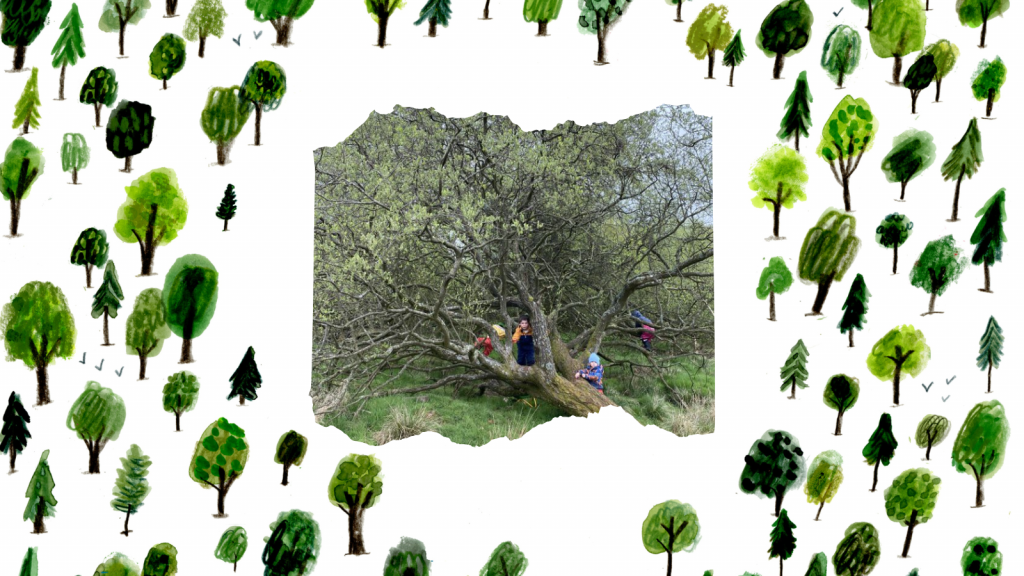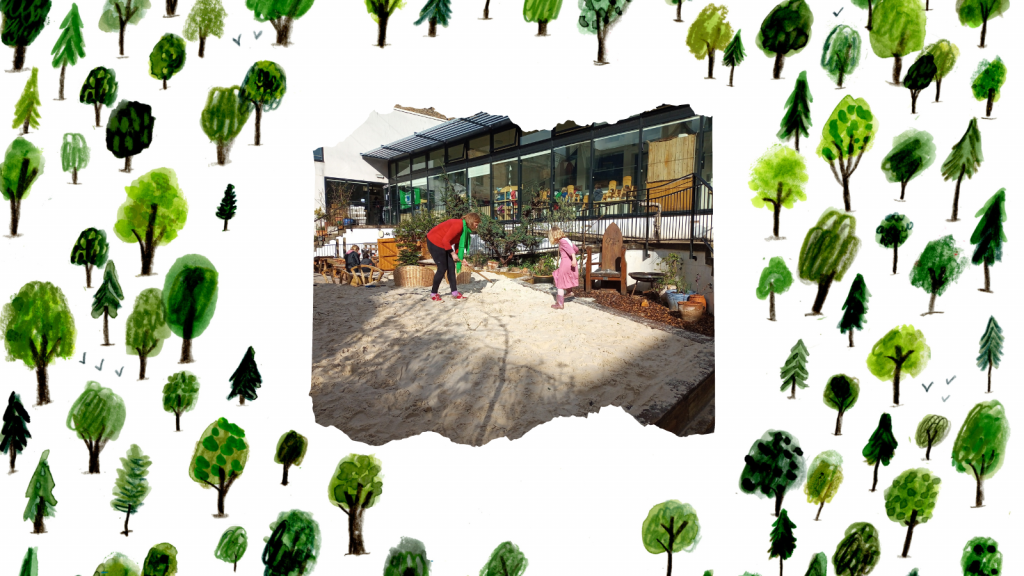We wanted to share examples and experiences from the children and adults we engaged with. We are not Early Years experts but we can gather these views under a children’s human rights framework to offer a way forward. When reflecting on our practice, we noted that although children shared their positive experiences of Outdoor Learning, we also noticed that the curriculum was not easy for them to engage with in its full extent. Across our consultation it was also clear that provision is uneven across settings and not always accessible or well resourced.
We were delighted to spend time at FossoPLAY, a Forest Nursery in Perthshire. The children remain outdoors for their whole day and can shape the areas they play in through suggesting new structures and materials to the staff. A particular favorite of ours was their canvas shelter where we worked with Emily Mackenzie, our project illustrator.
Fully situated in a forest setting, the children had a tangible connection to outdoor learning and physical environment concepts such as seasons, plant life and nature.
If I stand in the sun, I can photosynthesize like a plant!
MCP, FossoPLAY Nursery
The head of nursery and other staff at FossoPLAY felt that their access to high quality and large amounts of outdoor space greatly contributed to the children’s wellbeing and this engagement with the curriculum we observed. It allowed all activities to be underpinned by outdoor learning, rather than being siloed into other sections of educational delivery. It also meant that children’s right to play could be well met as activity was child-led and emerged through children exploring their nursery grounds.
A question emerged when we reflected together with FossoPLAY was whether every nursery in Scotland (and therefore every child attending nursery) could have access to the same quality of outdoor learning provision. In addition to the resources needed, settings would also need to ensure that children’s human rights were prioritized in practice to value and promote child-led play in these spaces. There are also clear land use barriers where nurseries are in urban areas or face other resourcing difficulties.
Perhaps the new Learning for Sustainability Action Plan and other educational changes can prioritize this, especially in the crucial ages of Early Years children to meet their needs.

Cowgate Under 5’s centre is located in central Edinburgh. This was a very interesting contrast for us to visit after the Forest nursery. It seems obvious that their provision for outdoor learning would be less tangible or less extensive, but when we dug a little deeper, we found this wasn’t the case.
Cowgate follows the Froebelian method, which you can read about more here. The centre prioritizes the use of materials sourced from nature and is also completely child-led. This includes supporting the children off-site to explore topics that they express interest in.
I love coming to Cowgate because I get to see the squirrels and play in the fairy house outside
MCP, Cowgate Under 5’s
My favourite thing in Cowgate are the leaves
MCP, Cowgate Under 5’s
While we are not experts on the Froebelian method, it was interesting to see where this overlapped with the fulfilment of children’s human rights from our perspective. Child-led play and learning here allowed the MCPs to be genuinely curious and invested in their physical environment. It also allowed them the time and support to foster healthy emotional development and relationships, something that practitioners at Cowgate Under 5’s wanted to see prioritized in the new Learning for Sustainability Action Plan.

While we can’t provide answers for all the questions and reflections that emerged from our project, we can shed light on the power of engaging Early Years children in consultations and participation. UNCRC incorporation will have to meet the needs of every child in Scotland, including ages 0-4. Solutions can’t just be delivered through school settings and must interrogate the spaces and places children live and play in across ages and locations.
The children we engaged with were passionate, curious and cared for their nursery spaces. They wanted to learn more about the world around them, without imposed adult buildings or curriculum, and shared that this had a positive impact on their wellbeing. We were delighted to be led on fairy hunts and drawing activities exploring the children’s weird and wonderful favourite animals. Every time, it felt difficult to say goodbye at the end of our session.
As adults, we need to see that no one implementation method or curriculum refresh can alone meet the needs of every age. It is vital to preserve the playful, the whimsical and the unknown and these need to be supported by changes to the structures they exist in, whether a building or a model for educational delivery. Here at Children’s Parliament, we have a vision away from one size fits all: culture change at the very heart of how we act and how we think about all children.
You can read our full children’s report here on the Learning for Sustainability Action Plan and report gathering the adult interviews together here.